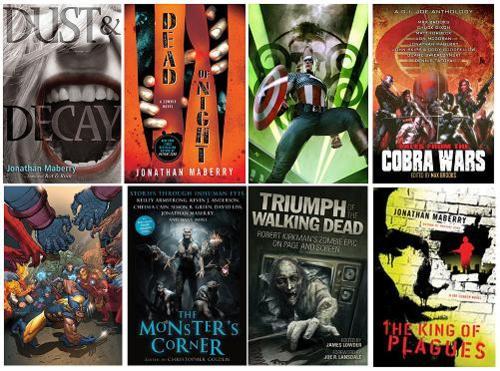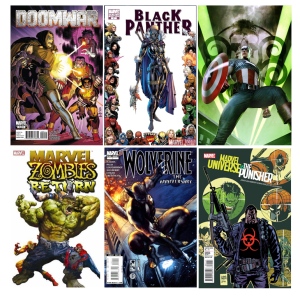Saturday, February 4, 2012
Jonathan Maberry: Man in Progress Part Two
The Interview
prepared by Anthony Servante
As we learned last month, Jonathan Maberry has progressed from Martial Arts disciplines in practice and instruction, to Folklore research, and onto Horror, where the Bram Stoker-Award winning author has earned the critics’ praise as the “next Stephen King”. He visits The Black Glove on his DEAD OF NIGHT Blog Tour.
Anthony Servante: This is Anthony Servante from The Black Glove speaking to Jonathan Maberry as he promotes his latest work, Dead of Night (2011). Thank you for joining us.
Jonathan Maberry: My pleasure, Anthony. Thanks for having me!
Anthony: Can we start with a little overview of the career of Jonathan Maberry? Where does your writing career begin?
Maberry: I made my first professional sale while a junior in college. There’s a saying in writing: ‘Write what you know’ –the logic being that if you pitch articles, stories, etc. based on the things you know and love best, then you’ll write with more passion and authority. I’ve been involved in martial arts since I was a little kid, so the first articles I pitched were on that. My first sale was to Black Belt Magazine, and I was off and running. I went on to sell around 1200 articles and 3000 columns. Then in the early 1990s, while teaching at Temple University, I began to write college textbooks. I did the books for my own courses –Martial Arts History, Self-Defense for Women, Jujutsu and others, and also for courses taught by colleagues (Judo, Archery, etc.)
A decade later I began publishing martial arts books for the mass market, and in 2001 I wrote my first non-martial arts book. That was the Vampire Slayers Field Guide to the Undead, written under the pen name of Shane MacDougall. Writing about the folklore of monsters gave me a taste for the horror genre, and in 2005 I wrote Ghost Road Blues, my first novel. Now I’m a full-time novelist and also write short stories and comics.
Anthony: Can you tell us lay people of the philosophy connected to your martial arts disciplines? Like the differences between Krav Maga, Kung Fu, and the disciplines you’ve earned belts in and written about?
Maberry: I’m a classicist when it comes to martial arts. I’ve been practicing (and later teaching) Japanese jujutsu and kenjutsu since 1966. Jujutsu was developed during Japan’s Feudal Era, and it was the combat system used by the samurai. It includes a variety of interrelated armed and unarmed fighting methods. It’s very scientific, heavily grounded in physics, physiology, anatomy, psychology and strategy. There are a lot of modern sport systems that are called ‘jiujitsu’ arts, but they’re really based more on Judo, which was developed as the nonviolent sports version of jujutsu. Classical jujutsu isn’t useful as a sport because the techniques were developed expressly for combat. To make them safe for sports requires a radical change in both the selection of skills and their application. It’s the difference between a Nerf ball and a bullet. Both of them can hit a target, but not at all in the same way.
There are essentially three categories of martial arts: combative, sportive and esoteric. The latter form includes arts like Aikido and Tai Chi, and while these arts do have a connection to their combative roots, their goal is the improvement of physical health and fitness and the cultivation of a harmonious mind. Sportive martial arts are the most popular, and these include everything from fencing to boxing, wrestling, judo, taekwondo, Brazilian jiujitsu, most forms of karate, and so on. Many of these arts are magnificent and are certainly excellent for teaching fitness, sportsmanship, discipline, and other virtues –but they are no longer the same as the combat arts on which they were based. Combative arts are much rarer and not particularly popular, largely because it’s much harder to earn rank, there is far more to learn, the techniques aren’t flashy, and it often hurts. The older Okinawan karate systems were combative, as is jujutsu, aikijutsu, kenjutsu (swordplay), Hapkido and a few others.
I admire sportive and esoteric arts, but I was trained for combat. Throughout most of my career as a professional instructor, I created self-defense programs for women, children, the elderly, and the physically-challenged, including a close-quarters combat system for the blind (Touch-Fighting) and one for folks in wheelchairs (Steel Wheels). More recently I was chief instructor of COPSafe, a company that provided arrest-and-control and personal defense workshops for all levels of law enforcement including SWAT.
In 2004 it was my very great honor to be inducted into the International Martial Arts Hall of Fame, due in part to my extensive writings.
Anthony: From martial arts you went on to Vampires, Zombies, Cryptids and the Science of Cryptozoology. Can you tell us just what that means and how you came to study the field of “hidden” monsters in nonfiction? Any favorite fantastical creatures in there?
Maberry: I’ve always had an interest in what my spooky ol’ grandmother called ‘the larger world’. She believed in everything from ghosts to vampires to sprites. She also believed that there were a lot of odd things in our own natural world that have not yet been recorded. Critters like the Jersey Devil, the Lake Champlain Monster, and others. Also I maintain a healthy skepticism I, like Fox Mulder, want to believe. I’m very open to the possibility that there are some strange things in our world, and science frequently rewards that optimism by discovering previously unrecorded species –or finding living examples of supposedly extinct species.
My wife and I are actually involved in one ongoing mystery involving a ‘cryptid’ (an animal not yet verified in the known fossil record). In Eastern Pennsylvania there have been hundreds of sightings of a weird animal that looks like a cross between a marsupial, a dog and a rodent. It was given the unfortunate nickname of the ‘Yardley Yeti’ by a local newsman who liked the alliteration but didn’t really know what a ‘yeti’ was. My wife and I saw it in 2006 and took photos of it
We don’t know what it is. I’d thought that it was a red fox with mange, but the exotic animals expert from the Norristown Zoo said that it wasn’t. He did not know what it was.
Anthony: Now if we can connect the dots: How did you create fiction from martial arts and nonfiction cryptids?
Maberry: In fiction, we want to build our stories on solid ground as much as possible. By tapping into things we all know about, or at least can recognize, it creates a shared environment for understanding. In my fiction, I generally back everything up with hard science and common sense. Everything is as real as I can make it–and I do a ton of research to get the details straight. If I introduce a transgenic super soldier, then I’ll pack the hard-core cutting-edge science into the story that explains how transgenics really could create such a creature. Science allows for that because we’re actually working on stuff like that. Hell, there are farms in Canada where they raise goats that have been given the silk-producing gene from the orb weaver spider; and as a result the goats produce prodigious quantities of spider silk in their milk. This is real, this is ten years ago.
The zombies in DEAD OF NIGHT move and act like the monsters in George Romero’s NIGHT OF THE LIVING DEAD, but I cooked up a plausible way for them to exist, using Cold War-era bioweapons science, ethnobotany courtesy of my friend Dr. Wade Davis (author of THE SERPENT AND THE RAINBOW), and new information about parasites from another friend, Carl Zimmer (author of PARASITE REX).
When it comes to martial arts in my stories, my heroes often have to go toe-to-toe with these monsters. Choreographing that kind of fight scene is easy for me because of my training in jujutsu. Remember, that’s a scientific art, so the science shows me the way.
Anthony: Can you give us some background on the Pine Deep Trilogy for new readers?
Maberry: The Pine Deep Trilogy (GHOST ROAD BLUES, DEAD MAN’S SONG and BAD MOON RISING) are set in a small and very troubled little town in Pennsylvania. The town of Pine Deep has built its industry and tourism around its reputation for being the most haunted town in America. The problem is that it really IS the most haunted town in America, and that turns out to be a very bad thing for everyone–locals and tourists.
I tapped a bit of legend from Eastern Europe that is well-documented in folklore but never tapped (before) in fiction. The legend has it that when a werewolf dies-and is not buried on hallowed ground—it comes back as a vampire. A very powerful vampire, and one capable of creating more vampires–not by its bite but by causing the bodies of victims of violent deaths to rise from their graves. This vampire is building an army and plans to make war on humanity.
One of the fun things I did in that series is to include a number of real people. Since Pine Deep has a big Halloween festival–and since festivals of that type generally have celebrities from horror films—I asked some real horror film celebs if I could write them into the story as themselves. They’re in town as guests of the event when things suddenly turn very bad. So you can expect to see Tom Savini, James Gunn (screenwriter of the remake of DAWN OF THE DEAD and director of SLITHER), Stephen Susco (screenwriter for THE GRUDGE), Joe Bob Briggs (drive-in movie critic), Ken Foree (star of the original DAWN OF THE DEAD), scream queens Brinke Stevens and Debbie Rochon, and more.
Anthony: Can you catch us up with the Joe Ledger series?
Maberry: Joe Ledger is a former Baltimore cop who was recruited by a secret government agency to fight terrorists who are using radical bioweapons. In the first book, PATIENT ZERO, Joe dealt with terrorists who had bioengineered a new form of Mad Cow disease to create a kind of zombie plague; in THE DRAGON FACTORY, Joe tackles scientists using cutting-edge transgenic science to restart the Nazi Master Race program; in THE KING OF PLAGUES, Joe’s team squares off against a secret society using weaponized versions of the Ten Plagues of Egypt. Now, in the latest thriller, ASSASSIN’S CODE, Joe and the Department of Military Sciences try to stop an ancient order of killers from detonating nukes throughout the Middle East. The kicker there is that these assassins have an unusual thirst for human blood.
ASSASSIN’S CODE debuts April 10 from St. Martin’s Griffin (in trade paperback, ebook and audio).
Anthony: And Benny Imura? Can we have a synopsis of this character and his series?
Maberry: Benny Imura is a fifteen year old kid growing up in post-apocalyptic California. Fourteen years ago the Reaper plague swept across the world, turning most of the world’s population into mindless, flesh-eating zombies. Benny and his friends live in a small fenced-in town and the rest of the world is the great ROT & RUIN. Now Benny has to get a job of face having half his rations cut. He reluctantly apprentices with his zombie-killer half-brother, Tom. That changes everything. Benny quickly learns that everything he knew about the world, his family, and the zombies, was wrong.
ROT & RUIN was the first book in what will be a quadrology. It’s already won a slew of awards and is nominated for about a dozen others. The second in the series, DUST & DECAY, debuted last August and is a finalist for the Bram Stoker Award. The third book, FLESH & BONE, debuts September 11, and I’m just about to start writing the concluding book, FIRE & ASH.
Anthony: How did you get into the comic book world of Marvel? I’m a Silver Age Marvel geek. What have you done to our favorite heroes? What’s your spin?
Maberry: I grew up reading Marvel Comics. I remember walking into our neighborhood magazine shop when I was nine years old and buying my first comic–Fantastic Four #67. I was immediately hooked. Roll forward a bunch of years, and a few months after PATIENT ZERO came out, I get a totally unexpected phone call from Marvel’s Editor in Chief, Axel Alonso. He said he’d read PATIENT ZERO, really dug it, and wanted to know if I’d like to write for Marvel.
Turns out…yeah, I did.
Over the last few years I’ve had a chance to write stories that involved almost all of my favorite characters: The Fantastic Four, Black Panther, Spider-Man, the X-Men, Captain America, the Punisher, Wolverine. Prince Namor. I’d love to do a reboot of Tomb of Dracula, or maybe a new spin on the Warlord of Mars series. Time will tell.
Right now I’ve been writing my own little franchise within Marvel–a kind of Rage Virus story that gives a bit of a nod to 28 Days Later and I Am Legend. The first series was MARVEL UNIVERSE VS THE PUNISHER. We followed that up with MARVEL UNIVERSE VS WOLVERINE, which was just nominated for a Bram Stoker Award.
Anthony: What do you have in the works that we can look forward to?
Maberry: In May, V WARS debuts. It’s a shared-world vampire anthology that I cooked up and edited. It features novellas by Nancy Holder, Scott Nicholson, John Everson, Yvonne Navarro, Gregory Frost, Keith DeCandido, and James A. Moore.
Plus I have a slew of short stories coming out this year. One just hit stores, “The Death Song of Dwar Guntha”, a John Carter of Mars story in the anthology UNDER THE MOONS OF MARS (in hardcover from Simon & Schuster), and I’ll have a fantasy novelette, “Spellcaster 2.0”, in AN APPLE FOR THE CREATURE, an anthology edited by Charlaine Harris and Toni Kellner (September 4 from Ace). And lots of others. Even a story in an anthology called BEFORE PLAN 9: Plans 1 Through 8 From Outer Space.
Anthony: Fantastic. Thank you for visiting The Black Glove on your DEAD OF NIGHT Blog Tour.
Maberry: Hey, this was fun! Thanks, Anthony!
Readers can turn to the Servante of Darkness review of DEAD OF NIGHT for more of Jonathan Maberry: Man in Progress, Part Two. And we’ll see you, dear readers, for Part Three next month with some surprises from our special guest.
END
***********************
Jonathan Maberry is a NY Times bestselling author, multiple Bram Stoker Award winner, and Marvel Comics writer. He’s the author of many novels including Assassin’s Code, Dead of Night, Patient Zero and Rot & Ruin. His nonfiction books on topics ranging from martial arts to zombie pop-culture. Since 1978 he has sold more than 1200 magazine feature articles, 3000 columns, two plays, greeting cards, song lyrics, poetry, and textbooks. Jonathan continues to teach the celebrated Experimental Writing for Teens class, which he created. He founded the 'Writers Coffeehouse' and co-founded 'The Liars Club'; and is a frequent speaker at schools and libraries, as well as a keynote speaker and guest of honor at major writers and genre conferences. Jonathan lives in Bucks County, Pennsylvania with his wife, Sara and their son, Sam. Visit him online at www.jonathanmaberry.com and on Twitter (@jonathanmaberry) and Facebook.
******************
Praise for DEAD OF NIGHT:
“Jonathan Maberry is the top gun when it comes to zombies, and with DEAD OF NIGHT, he's at the top of his game. Frankly, I'm shocked by how effortlessly he moves between the lofty intellectual heights of T.S. Eliot's poetry and the savage carnality of the kill. DEAD OF NIGHT develops with the fevered pace of a manhunt, and yet still manages to hit all the right notes. Strap in, because Maberry's latest is one hell of a wild ride. I loved it.” - Joe McKinney, author of DEAD CITY and FLESH EATERS
“Jonathan Maberry has created an homage to death itself and an homage to the undead that is as poetic as it is terrifying. It's a brand new and intriguingly fresh slant on the zombie genre that we all love!” -John A. Russo co-screenwriter of NIGHT OF THE LIVING DEAD
“Maberry is a master at writing scenes that surge and hum with tension. The pacing is relentless. He presses the accelerator to the floor and never lets up, taking you on a ride that leaves your heart pounding. It’s almost impossible to put this book down. Dead of Night is an excellent read.” —S.G. Browne, author of BREATHERS
"It would be enough to say that Jonathan Maberry had topped himself yet again with an epic zombie novel that is as much fun as it is terrifying. But that he has also created a story of such tremendous heart and social relevance only further cements his place as a master of the genre. It also doesn't hurt that in DEAD OF NIGHT he has created one of the most compelling heroines I've read in years. Dead of Night blew me away!" --Ryan Brown - Author of PLAY DEAD
“Once again, Jonathan Maberry does what he does best; Take proven science, synthesize it and create something truly terrifying. In DEAD OF NIGHT, Maberry lays the groundwork for a Bioweapon that could very well create zombies in the real world. Combining great characters (I fell in love with Dez Fox from the moment she was introduced) and taut, blindingly fast action, DEAD OF NIGHT, is a runaway bullet train of a ride. This is Jonathan Maberry's best writing yet.” –Greg Schauer, owner Between Books, Claymont, DE
“Dead of Night stands drooped head and lurching shoulders above most zombie novels. The nightmare increases exponentially - from minor outbreak to major crisis with unstoppable speed, building to a heart-stopping climax you won't be able to put down.” --David Moody, author of the HATER and AUTUMN books
--Anthony Servante











